ASA Podcast Spotlight: Subcontractor Shares How Tech Curiosity Transformed AP
The American Subcontractors Association is excited to spotlight this episode of The Power of Change podcast, featuring Shawn Robinson, Accounts Payable Manager at ASSA ABLOY.
In this episode, Shawn shares how his construction finance team embraced curiosity and change to modernize their accounts payable process. By implementing AvidXchange’s AP automation solution, they cut manual payment processing time by 76%—saving time, reducing errors, and freeing up their small team to focus on strategic work.
Key insights for subcontractors:
- Build internal buy-in: Shawn shares tips on leading change from within by involving your team early.
- Get time back: With automation in place, his team is now focused on value-added work instead of chasing paper invoices.
- Stay curious: His advice to fellow subcontractors—stay “a little nerdy” and keep exploring tools that simplify your operations.
Whether you're just starting to explore AP automation or looking to scale efficiencies, this episode offers inspiration and practical advice from one subcontractor to another.
September - National Preparedness Month
September is National Preparedness Month, an initiative designed to enhance emergency readiness across the nation. Though this timing coincides with peak hurricane season as we transition from summer to autumn, emergency preparedness remains vital year-round since natural disasters strike without warning.
The financial toll of weather-related disasters continues to escalate. In 2024, the United States experienced 27 confirmed weather and climate disasters, each causing damage exceeding $1 billion. These disasters included 17 severe storm events, 5 tropical cyclone events, 2 winter storm events, 1 drought event, 1 flooding event, 1 wildfire event. On average the United States allocates approximately $150 billion annually toward climate disaster recovery efforts.
Weather related events cause unique challenges for the construction industry with significant financial impact. Please review the natural resource guide for ASA members. FASA's guide offers guidance, including the following:
- Federal resources to consult or contact before, during and after the event
- Insights on commercial property insurance, specifically for the types of disasters it may not cover flood, hurricanes and earthquakes.
- Legal and contract considerations on projects following a disaster.
Please visit FASA Natural Disaster guide for resources and information.
ASA Supports the Michael Enzi Voluntary Protection Program Act
The Michael Enzi Voluntary Protection Program Act (H.R. 2844) would require the Secretary of Labor to establish a voluntary protection program (VPP), recognizing employers’ voluntary commitment to establishing comprehensive safety and health management systems. This legislation encourages collaborative partnerships between the regulated community and the Occupational Safety and Health Administration (OSHA), such as VPPs, benefits both parties by improving compliance efficacy, reducing financial and administrative costs for both parties, and strengthening trust and transparency between the agency and employers.
Expanding compliance assistance initiatives such as VPPs, as proposed in H.R. 2844, would promote a more proactive approach to workplace safety. By encouraging employers to design and implement their own comprehensive safety and health management systems, VPPs empower businesses to take ownership of their safety performance and enables OSHA to formally recognize and reward employers who demonstrate a strong commitment to worker safety and compliance. These recognized employers benefit from the ability to undergo regular self-evaluations, maintaining high safety standards while avoiding routine inspections that disrupt daily workplace operations.
VPPs have a proven success rate at reducing occupational injuries and illnesses, per OSHA’s own data. The average VPP worksite has a Days Away Restricted or Transferred (DART) case rate of 52 percent below the industry average. Further, self-reported 2021 injury and illness rates suggest that site-based non-construction VPP participants avoided approximately 4,035 Total Case Incident Rate (TCIR) injuries within their respective industries, putting those businesses 54 percent below the Bureau of Labor Statistics (BLS) TCIR rate. The construction industry is no different; in the same year, construction and mobile workforce VPP participants were, on average, also 54 percent below the BLS TCIR Rate for their industry.
Moreover, VPPs help reduce financial and administrative costs for both employers and OSHA. Employers that participate in VPPs experience fewer workplace injuries and illnesses, leading to lower workers' compensation costs, reduced downtime, and increased productivity. Further, by maintaining safety and health programs, these employers require fewer OSHA inspections, allowing the agency to focus its limited resources on higher-risk workplaces and truly bad actors who fail to commit to maintaining a safe workplace. This improved efficiency reduces the administrative burden for both parties, streamlines compliance processes, and fosters a culture of continuous improvement; ultimately saving time and money while enhancing workplace safety.
NEMA Equips Electrical Contractors Toolkit to Educate Consumers About Electrical Safety for Home Construction & Renovation
The Electrical Contractor’s Toolkit is designed specifically as a resource for use by electrical contractors, electricians and businesses in the electrical services industry to help communicate factual and up-to-date information regarding electrical safety; proactive tips to keep homeowners safe; the importance of electrical fire prevention technology and requirements; and the affordability of electrical protection.
Content provided for free in the communications kit includes:
- Homeowner’s Guide to Preventing Electrical Fires
- Proactive Prevention
- Arc-Fault Circuit Interrupter (AFCI) Fact Sheet
- FAQ
- Infographic
- Tripping Guide
- Website and Social Media Content + Photos
“Our hope is the electrical community will consider utilizing these materials in their customer communications including print, online and social channels, helping to further educate the public about the importance of making sure their homes are protected and in compliance with National Electrical Code® requirements,” said Ashley Bryant Kees, chair of the NEMA LVDE AFCI Task Force.
The toolkit is being distributed nationwide to electrical industry groups to share with members and is also available to download for free at https://tinyurl.com/ECToolkitDownload. More information on AFCIs can be found at www.AFCISafety.org

OSHA poster (English): 5 things you should know that could help prevent suicide
OSHA poster (Spanish): 5 cosas que debes saber que podrían ayudar a prevenir el suicidio
Video resources for Suicide Prevention:
Building Stronger Together: Peer Support as a Mental Health Strategy in Construction | CSPW is kicking off Suicide Prevention Month with a webinar focused on the vital role of peer support in suicide prevention efforts across the construction industry. Hear from industry peer support experts about how to develop, expand and sustain peer support networks — and how to plan strategically to create safer, more supportive workplaces for the years to come. (Moderator: Josh Vitale, Project Built | Speakers: Josh Rizzo, Josh Rizzo Human and Justin Azbill, The Tribal Group LLC)
Behind the Scenes, On the Front Lines: How Human Resources, Safety and Marketing Drive Suicide Prevention Culture | Suicide prevention in construction isn’t just about one department — it’s a cross-functional effort that requires alignment, communication and commitment from every corner of an organization. In this panel discussion, leaders from HR, safety and marketing share how their roles contribute to building a culture of psychological safety, trust and care. This session will offer practical takeaways for how these often “behind-the-scenes” departments can collaborate to create a safer, more supportive environment — because preventing suicide starts with how we talk, listen and lead. (Moderator: Kara (Houck) McCaffrey, Houck Group, Inc.| Speakers: Molly Cape, MTech Mechanical; Wendy Hudson, Weitz; Tom Ruzicka, Delta Innovative Services, Inc. )
From Crisis to Culture Shift: How to Build a Resilient WorkforceNavigating the Opioid Crisis: a Workplace Perspective | This session moves beyond crisis response to explore proactive, culture-driven strategies that build resilience at every level of a construction organization. Instead of waiting for employees to reach a breaking point, leaders can take small, impactful steps to create a work environment where mental health is protected, stress is managed and employees feel supported. (Speaker: Stephanie Lemek, The Wounded Workforce
Remember UPS This Fall

Transform your shipping experience this fall with UPS My Choice® for Business. Gain more control, track with ease, and unlock exclusive ASA member benefits. Sign up now and streamline your operations! https://www.savewithups.com/asamembers | #BeyondSavings
